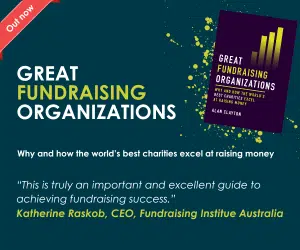10 things fundraisers could learn from Star Wars

“A long time ago, in a charity not so far away…”
With the new Star Wars movie tantalisingly close and excitement growing around the release I was recently challenged to write a blog about what fundraisers could learn from the films. I’m aware I’m light-years late to this party – Agents of Good have done a whole series of Star Wars inspired blogs, and if you are not following @FundraisingYoda you are missing out.
So, instead, this blog is a prequel to the others…
1. Keep your friends close
Throughout the films, the various characters put themselves on the line to help each other. The strength of their relationships meant they were willing to go the extra mile.
As fundraisers, we always talk about the importance of building and maintaining relationships with supporters. We know that having a genuine, personal connection between the donor and the cause is a key driver of greater Life Time Value. However, engaged supporters are also the ones that can help you when your cause is in trouble.
This help doesn’t just come in the form of financial support and, while they may not put their lives on the line to help you blow up a spaceship, these supporters can come to your rescue in other ways. This could include offering advice, giving in-kind support or advocating for your cause in the face of enemy onslaught.
Advertisement
2. You need to have a plan
Blowing up the Death Star and fundraising have at least one thing in common – you need to have a strategy in place before you can begin. For fundraising (and probably for blowing up the Death Star, although =mc has less experience in this area) this should include a SWOT and PEST analysis. This will give you a clear understanding of what the rules of the game are, what league you are in, and how strong your team is.
You also need to decide what is the best structure for your organisation and team – is this something you have the expertise to do in-house, or do you need additional help?
3. It’s a Team Game
The central cast of Star Wars was noted for its diversity (questionable family relationships aside). As with taking on the Dark Side, fundraising is a team activity. You need to identify what skills you need in your team to achieve your fundraising strategy and invest in ensuring they have the competencies required.
(As Yoda rightly says, “Already know you that which you need.”)
You also need to make sure your Senior Management Team and Trustees/Board/Intergalactic Senate are engaged. Be clear about what is expected of them – whether that is acting as ambassadors, making introductions to their networks or donating in their own right. Ensure you have appropriate lines of communication and a framework for reporting internally, with information passing both ways. (Find out more about =mc’s Leadership Programme.)
4. Attack of the Clones

How can you tell one Storm Trooper from another? Aren’t they all exactly the same? Sadly, people often have the same criticism of charities and charity mailings. You need to be able to articulate what makes you different from organisations working in a similar space. Are you clear what your USPs are and what this means for your donors and prospects? How can you use them to make sure your message has impact, is noticed and is remembered?
Linked to this, it is really easy to tell when a mailing or “thank you” note has been cloned. It doesn’t take much time or effort to personalise your communication but the impact it has is huge.
5. You have the power to change someone’s mind
Both Jedis and fundraisers often find they need to influence people. However, while Jedis can use mind tricks to get people to change their minds, fundraisers have to rely on more worldly skills to give donors what they want and to help them make decisions. Understanding how people make decisions is a key skill for a fundraiser.
One of the ways fundraisers can do this is by understanding the “5 P’s of Influence” – Passion, Proposal, Preparation, Persuasion and Persistence. Another way that you can understand how people make decisions is through Behavioural Economics.
Pioneered by Daniel Kahneman, Behavioural Economics shows that, while we would like to think we make decisions very rationally, most of the time our rationality is limited by our ability to work things out, the large amount of information available, the limited relevant knowledge we have, and our own lack of time and energy.
6. The Jar Jar Anomaly
I must confess I am not a massive sci-fi fan but there is no doubt in my mind that the best character in Star Wars is Jar Jar Binks. So imagine my surprise to find that not everybody shares my love for the “bumbling Gungan”. In fact, he seems to be universally hated.
How can this be true? Well – it turns out that, when it comes to sci-fi films, “I am Not the Target Market”. In fundraising terms, we can get caught up on an idea or campaign that we like and ignore the fact that it is not having the required effect with our target audience. It can be hard to kill off something that we have grown personally attached to but, when it comes to fundraising, it is what works for your donors and your prospects that matters most.
The Boston Matrix can help you identify which campaigns should be protected, and which ones should be killed off.
7. The Power of Sorry

Sticking with Jar Jar for a little bit longer (sorry), it is important to remember the power of the apology. We all make mistakes and charities are no different. Sometimes the mistake might be to do with the organisation’s work generally and other times the mistake might relate to our relationship with a specific donor. At =mc we refer to these as “Coffee Stain moments”. What is important is how you respond to the mistake.
The first step is to acknowledge the mistake and apologise promptly (I’d suggest not doing it in a Jar Jar voice). You then need to work with your donor(s) to identify how you can stop the mistake being repeated. Involving the donor(s) in this can help turn your Coffee Stain moment into a more positive “Moment of Truth”.
In particular, Trust funders are keen to hear what hasn’t worked, as well as what has. This helps them to share expertise with other organisations and can influence their own grant-giving.
So, while it may be tempting to only tell the positive side when reporting back to one of the Death Star’s funders (ability to efficiently destroy planets etc) you should also flag any challenges you faced and what you have learned from them (e.g. Death Star is liable to explode when shot in the right place. Next time we need better protection for thermal exhaust pipes).
8. Much to learn you still have
Good fundraisers realise that the world around them is always changing and that there will always be things to surprise them and for them to learn. Attending training courses, networking with peers, attending conferences and donating to other causes are all ways of seeing what others are doing and continuing your own personal development.
Having identified areas for your own improvement, work with your team to develop your skills. And don’t forget that knowledge flows both ways – pass on what you have learned you must.
9. There’s a funder for everything
When running training sessions and workshops we often talk about the fact that there is a funder for every project. The challenge is to understand how to package your project to match the donor’s aims, motivations and capacity to give.
In 2013, 2,388 people pledged over £325,000 on Kickstarter to fund the design and build of a Death Star, despite the devastating consequences it could have for Earth. In response to this imminent threat to our global security, 623 people pledged over $720,000 for a squadron of X-Wing fighters. (Sadly, the projects’ targets were £20 million and $11 million respectively, so neither received the funding.)
10. Protect your Rights!
In 1976, when negotiating his contract to direct the first Star Wars film, George Lucas reportedly turned down a 300% pay rise. Instead, he asked to retain the merchandising rights, as well as the rights to any sequels. At the time, this seemed a fantastic deal for Fox – they had previously had their fingers burnt with merchandising and there was no guarantee the film would be a success.
Jump forward to today and that decision has earned George Lucas an estimated $7 billion.
At a time when organisations are looking to diversify their income streams, a key skill is understanding the assets at your disposal and how they could be commercialised. Ansoff’s Matrix is a useful tool for considering your offering and your audiences. Similarly, if you are developing an earned income these Seven Key Considerations provide a useful framework.
So there we go – 10 things I think we can learn from Star Wars…and all without mentioning “The Force”. However, I’m sure there are many more, so join in the discussion – what other lessons do you think we can learn from Star Wars?
David Burgess – Fundraising Consultant, The Management Centre (=mc). (@davidburgessmc).
David is now at Apollo Fundraising.
- Star Wars Landspeeder to be auction on eBay for Children in Need (15 November 2019)
- Unicef prize draw offers a role in Star Wars Episode VII (2 June 2014)
- Charities that creatively hijacked May the Fourth – #StarWarsDay (4 May 2016)


![[ad] Blackbaud - supercharge your fundraising programmes - download now](https://fundraising.co.uk/wp-content/uploads/2025/03/blackbaud-supercharge-fundraising-202503-728x90_UK.jpg.webp)


